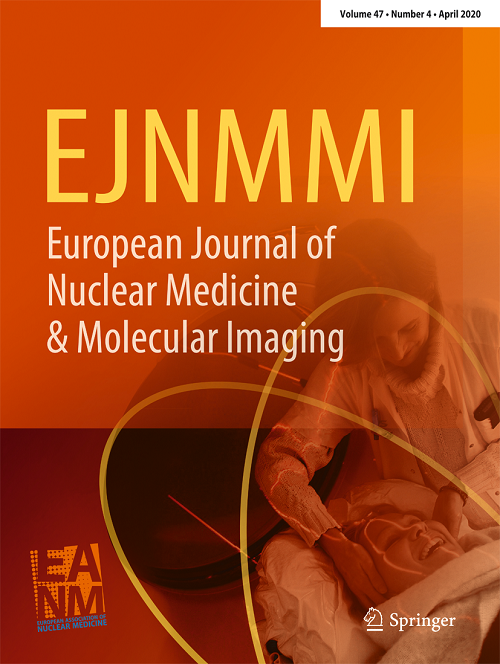天然配体激发肽用于c-MET靶向PET探针的开发。
IF 7.6
1区 医学
Q1 RADIOLOGY, NUCLEAR MEDICINE & MEDICAL IMAGING
European Journal of Nuclear Medicine and Molecular Imaging
Pub Date : 2025-06-16
DOI:10.1007/s00259-025-07403-y
引用次数: 0
摘要
目的性配体衍生肽极大地促进了靶向配体在放射性药物发现和设计中的发展。在此,我们报告了基于内源性生物分子肝细胞生长因子(HGF)开发新型间充质上皮转化因子(c-MET)靶向肽正电子发射断层扫描(PET)探针的首次尝试。方法利用HGF的n端和kringle 1结构域(NK1: 32-207个氨基酸残基)设计3个c-MET靶向肽。然后与螯合剂1,4,7,10-四氮杂环十二烷-1,4,7,10-四乙酸(DOTA)偶联,并用[68Ga]GaCl3进行放射性标记。对得到的[68Ga] ga标记探针、[68Ga]Ga-DOTA-K1、[68Ga]Ga-DOTA-A-C5和[68Ga]Ga-DOTA-A-M8进行体外和体内评价。结果3种PET探针中,[68Ga]Ga-DOTA-A-M8对c-MET具有高亲和力(IC50 = 5.43 nM),在高表达c-MET的HCT-116细胞中具有特异性和高摄取性。使用[68Ga]Ga-DOTA-A-M8在120分钟内进行小动物PET/CT成像,肿瘤清晰可见,对比良好。定量分析PET图像显示HCT-116模型注射后30分钟[68Ga]Ga-DOTA-A-M8的肿瘤摄取为2.91±0.20%ID/g。探针主要通过肾脏-膀胱通路清除。生物分布研究显示,注射后30min,正常组和阻断组HCT-116的肿瘤摄取率分别为2.84±0.07%ID/g和0.54±0.09%ID/g。30min时,肿瘤与肌肉、肿瘤与血液、肿瘤与肝脏的比值分别为3.60±1.09、1.48±0.24和2.48±0.28。结论本研究成功研制了一种新型c- met靶向PET探针[68Ga]Ga-DOTA-A-M8。它具有很高的肿瘤靶向能力和特异性。本研究强调了基于天然配体开发PET探针是一种强大且可推广的策略。本文章由计算机程序翻译,如有差异,请以英文原文为准。
Native Ligand-Inspired peptides for c-MET targeted PET probes development.
PURPOSE
Native ligand-derived peptides have significantly advanced the development of targeting ligands in radiopharmaceutical discovery and design. Herein, we report the first attempt to develop novel mesenchymal-epithelial transition factor (c-MET) targeted peptide positron emission tomography (PET) probes based on the endogenous biomolecule, hepatocyte growth factor (HGF).
METHODS
Three c-MET targeted peptides were designed from the N-terminal and kringle 1 domain (NK1: 32-207 amino acid residues) of HGF. Then they were conjugated with chelator 1,4,7,10-tetraazacyclododecane-1,4,7,10-tetraacetic acid (DOTA) and radiolabeled with [68Ga]GaCl3. The resulted [68Ga]Ga-labelled probes, [68Ga]Ga-DOTA-K1, [68Ga]Ga-DOTA-A-C5, and [68Ga]Ga-DOTA-A-M8 were evaluated in vitro and in vivo.
RESULTS
Among three PET probes, [68Ga]Ga-DOTA-A-M8 exhibited a high affinity for c-MET (IC50 = 5.43 nM) and demonstrated specific and high uptake in c-MET highly expressing HCT-116 cells. Small animal PET/CT imaging clearly visualized the tumor with good contrast using [68Ga]Ga-DOTA-A-M8 over 120 min. Quantitative analysis of PET images revealed tumor uptake of [68Ga]Ga-DOTA-A-M8 at 30 min post-injection was 2.91 ± 0.20%ID/g in HCT-116 models. The probe was mainly cleared out through the kidney-bladder pathway. Biodistribution study showed HCT-116 tumor uptake of 2.84 ± 0.07%ID/g and 0.54 ± 0.09%ID/g in the normal and blocking mice group, respectively, at 30 min post-injection. The tumor-to-muscle, tumor-to-blood and tumor-to-liver ratios were 3.60 ± 1.09, 1.48 ± 0.24 and 2.48 ± 0.28, respectively, at 30 min.
CONCLUSION
A novel c-MET-targeting PET probe, [68Ga]Ga-DOTA-A-M8, has been successfully developed in this study. It demonstrates high tumor-targeting capability and specificity. This study highlights developing PET probes based on native ligands is a powerful and generalizable strategy.
求助全文
通过发布文献求助,成功后即可免费获取论文全文。
去求助
来源期刊
CiteScore
15.60
自引率
9.90%
发文量
392
审稿时长
3 months
期刊介绍:
The European Journal of Nuclear Medicine and Molecular Imaging serves as a platform for the exchange of clinical and scientific information within nuclear medicine and related professions. It welcomes international submissions from professionals involved in the functional, metabolic, and molecular investigation of diseases. The journal's coverage spans physics, dosimetry, radiation biology, radiochemistry, and pharmacy, providing high-quality peer review by experts in the field. Known for highly cited and downloaded articles, it ensures global visibility for research work and is part of the EJNMMI journal family.

 求助内容:
求助内容: 应助结果提醒方式:
应助结果提醒方式:


